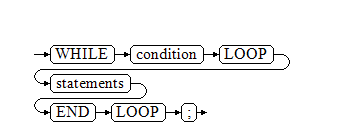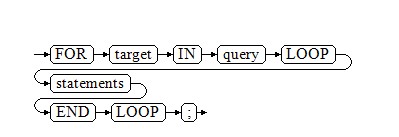Loop Statements
Simple LOOP Statements
Syntax diagram

label declaration ::=

Example
1 2 3 4 5 6 7 8 9 10 11 12 13 14 15 16 17 18 19 20 21 22 |
gaussdb=# CREATE OR REPLACE PROCEDURE proc_loop(i in integer, count out integer) AS BEGIN count:=0; LOOP IF count > i THEN raise info 'count is %. ', count; EXIT; ELSE count:=count+1; END IF; END LOOP; END; / CREATE PROCEDURE gaussdb=# CALL proc_loop(10,5); INFO: count is 11. count ------- 11 (1 row) |

The loop must be exploited together with EXIT; otherwise, a dead loop occurs.
WHILE_LOOP Statements
Syntax diagram

label declaration ::=

If the conditional expression is true, a series of statements in the WHILE statement are repeatedly executed and the condition is decided each time the loop body is executed.
Example
1 2 3 4 5 6 7 8 9 10 11 12 13 14 15 16 17 18 19 20 21 22 23 24 25 26 27 |
gaussdb=# CREATE TABLE integertable(c1 integer) ; CREATE TABLE gaussdb=# CREATE OR REPLACE PROCEDURE proc_while_loop(maxval in integer) AS DECLARE i int :=1; BEGIN WHILE i < maxval LOOP INSERT INTO integertable VALUES(i); i:=i+1; END LOOP; END; / CREATE PROCEDURE -- Call the stored procedure. gaussdb=# CALL proc_while_loop(10); proc_while_loop ----------------- (1 row) -- Drop the stored procedure and table. gaussdb=# DROP PROCEDURE proc_while_loop; DROP PROCEDURE gaussdb=# DROP TABLE integertable; DROP TABLE |
FOR_LOOP (integer Variable) Statements
Syntax diagram

label declaration ::=


- The variable name is automatically defined as the integer type and exists only in this loop. The value of name ranges from lower_bound to upper_bound.
- When the keyword REVERSE is used, the lower bound must be greater than or equal to the upper bound; otherwise, the loop body is not executed.
Example
1 2 3 4 5 6 7 8 9 10 11 12 13 14 15 16 17 18 19 20 21 22 23 24 25 26 27 |
-- Loop from 0 to 5. gaussdb=# CREATE OR REPLACE PROCEDURE proc_for_loop() AS BEGIN FOR I IN 0..5 LOOP DBE_OUTPUT.PRINT_LINE('It is '||to_char(I) || ' time;') ; END LOOP; END; / CREATE PROCEDURE -- Call the stored procedure. gaussdb=# CALL proc_for_loop(); It is 0 time; It is 1 time; It is 2 time; It is 3 time; It is 4 time; It is 5 time; proc_for_loop --------------- (1 row) -- Drop the stored procedure. gaussdb=# DROP PROCEDURE proc_for_loop; DROP PROCEDURE |
FOR_LOOP Query Statements
Syntax diagram

label declaration ::=


- The variable target is automatically defined, its type is the same as that in the query result, and it is valid only in this loop. The value of target is the query result.
- You can use EXECUTE to add a dynamic query and use USING to insert parameters to the query. For details, see the dynamic query content in Example.
1 2 3 4 5 6 7 8 9 10 11 12 13 14 15 16 17 18 19 20 21 22 23 24 25 26 27 28 29 30 31 32 33 34 35 36 37 38 39 40 41 |
-- Display the query result from the loop. gaussdb=# CREATE OR REPLACE PROCEDURE proc_for_loop_query() AS record VARCHAR2(50); BEGIN FOR record IN SELECT spcname FROM pg_tablespace LOOP dbe_output.print_line(record); END LOOP; END; / CREATE PROCEDURE -- Call the stored procedure. gaussdb=# CALL proc_for_loop_query(); pg_default pg_global proc_for_loop_query --------------------- (1 row) -- Drop the stored procedure. gaussdb=# DROP PROCEDURE proc_for_loop_query; DROP PROCEDURE -- Dynamic query. gaussdb=# CREATE TABLE t1(id int); gaussdb=# INSERT INTO t1 VALUES(1); gaussdb=# DECLARE a int := 1; item t1%rowtype; BEGIN FOR item IN EXECUTE 'SELECT * FROM t1 WHERE id = :1' USING a LOOP RAISE INFO '%', item; END LOOP; END; / INFO: (1) ANONYMOUS BLOCK EXECUTE gaussdb=# DROP TABLE t1; |
FORALL Batch Query Statements
Syntax diagram

label declaration ::=


- The variable index is automatically defined as the integer type and exists only in this loop. The index value falls between low_bound and upper_bound.
- If SAVE EXCEPTIONS is specified, exceptions occurred during DML execution in the loop body are saved in SQL%BULK_EXCEPTIONS and an exception is thrown after the execution is complete. If there is no abnormal execution result in the loop, the loop will not be rolled back in the current subtransaction.
- When FORALL is used together with BULK COLLECT INTO, the INTO variable returns only the execution result of a single DML statement.
Example
1 2 3 4 5 6 7 8 9 10 11 12 13 14 15 16 17 18 19 20 21 22 23 24 25 26 27 28 29 30 31 32 33 34 35 36 37 38 39 40 41 42 43 |
gaussdb=# CREATE TABLE hdfs_t1 ( title NUMBER(6), did VARCHAR2(20), data_period VARCHAR2(25), kind VARCHAR2(25), interval VARCHAR2(20), time DATE, isModified VARCHAR2(10) ); CREATE TABLE gaussdb=# INSERT INTO hdfs_t1 VALUES( 8, 'Donald', 'OConnell', 'DOCONNEL', '650.507.9833', to_date('21-06-1999', 'dd-mm-yyyy'), 'SH_CLERK' ); INSERT 0 1 gaussdb=# CREATE OR REPLACE PROCEDURE proc_forall() AS BEGIN FORALL i IN 100..120 update hdfs_t1 set title = title + 100*i; END; / CREATE PROCEDURE -- Call the stored procedure. gaussdb=# CALL proc_forall(); proc_forall ------------- (1 row) -- Query the calling result of the stored procedure. gaussdb=# SELECT * FROM hdfs_t1; title | did | data_period | kind | interval | time | ismodified --------+--------+-------------+----------+--------------+---------------------+------------ 231008 | Donald | OConnell | DOCONNEL | 650.507.9833 | 1999-06-21 00:00:00 | SH_CLERK (1 row) -- Drop the stored procedure and table. gaussdb=# DROP PROCEDURE proc_forall; DROP PROCEDURE gaussdb=# DROP TABLE hdfs_t1; DROP TABLE |
Feedback
Was this page helpful?
Provide feedbackThank you very much for your feedback. We will continue working to improve the documentation.See the reply and handling status in My Cloud VOC.
For any further questions, feel free to contact us through the chatbot.
Chatbot





